When it pertains to creating a landscape that thrives, understanding the art of tree pruning is a must. Think of having the ability to form your trees with precision, ensuring their vigor and beauty for years ahead. By learning the vital strategies for proper cuts, timing, and structural training, you hold the secret to a flourishing outdoor room that will excite all who encounter it. However how do these pruning techniques genuinely impact the health of your trees and the overall landscape aesthetic?
Appropriate Trimming Cuts for Tree Health And Wellness
When it involves preserving the wellness of your trees, making appropriate pruning cuts is vital. Incorrect cuts can bring about condition, insect problem, and total tree decrease. To make certain the vigor of your trees, always start by using sharp, clean devices to make precise cuts.
Begin by recognizing isa certified arborist logo , a swollen area where the branch attaches to the trunk. Cutting simply outside the collar aids advertise proper recovery and decreases the danger of infection. Avoid leaving stubs as they can welcome pests and illness into the tree.
Remember to make cuts at a mild angle, sloping far from the trunk, to avoid water from merging on the wound. In addition, remove any type of dead, harmed, or crossing branches to enhance air blood circulation and sunlight penetration.
Timing and Regularity of Pruning
To preserve the wellness and structure of your trees, comprehending the optimum timing and regularity of pruning is important.
The most effective time to prune trees is commonly throughout the dormant period in late winter months or early springtime. Pruning during this period helps advertise brand-new growth once the tree starts budding in the springtime.
Nonetheless, some trees, like spring-flowering ones, are best pruned right after they finish flowering to avoid cutting off next year's blossom buds.
Routine trimming is vital, however the frequency relies on the tree varieties and its growth rate. For many trees, an annual evaluation to remove dead, unhealthy, or going across branches is advised. Youthful trees might call for more constant trimming to develop a solid structure, while mature trees may only need maintenance pruning every couple of years.
Stay clear of pruning throughout the autumn when conditions are a lot more easily spread out, and avoid heavy trimming during the summer season when the tree is proactively growing.
Training Young Trees for Structure
For developing strong and healthy and balanced trees, training young trees for ideal framework is vital. By forming a tree when it's young, you set the foundation for a durable and aesthetically appealing mature tree.
Begin by determining the main leader, which is the major upward-growing branch. Urge the main leader's growth by pruning away completing leaders, helping the tree create a strong central trunk. In addition, get rid of any branches that grow internal or downward, as they can trigger structural issues as the tree expands.
It is very important to area out side branches uniformly around the trunk to advertise balanced growth. As the tree matures, remain to monitor its development and prune as needed to preserve its form and framework.
Correctly trained young trees are less most likely to establish weak crotches or chock-full branches, minimizing the risk of damages throughout storms. Investing time in training young trees will repay with a magnificently structured and durable tree in the future.
Conclusion
Now that you have actually mastered the vital methods of tree pruning, your landscape is on its way to flourishing. By utilizing sharp tools, making specific cuts, and correctly timing your trimming sessions, you are making certain the wellness and long life of your trees. Bear in mind to on a regular basis evaluate and keep your trees to keep them growing. With https://www.forbes.com/sites/houzz/2017/06/16/how-to-make-the-most-of-your-side-yard/ , your landscape will certainly remain to grow wonderfully for years ahead. Keep up the magnum opus!
